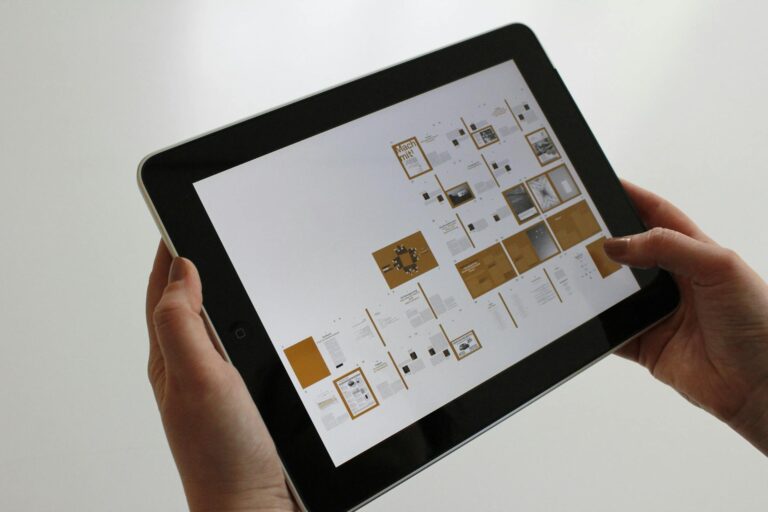Your 2025 Tech Trends Playbook for Business & Development
Navigating Tomorrow: Your Ultimate Playbook for 2025 Tech Trends in Business and Development
Estimated reading time: 14 minutes
Key Takeaways
- 2025 will be a pivotal year for digital transformation, emphasizing speed, scalability, and intelligent user experiences across web and mobile development.
- Next-gen frontends (Next.js), headless CMS, AI-powered web apps, and micro frontends are fundamentally reshaping modern web development.
- Mobile app innovation will focus on immersive UI/UX, deep AI integration, and the continued competition between cross-platform frameworks like Flutter and React Native.
- Cloud computing (especially serverless architecture and microservices) and DevOps best practices (including CI/CD automation) are crucial for driving efficiency, scalability, and agile development in businesses of all sizes.
- AI automation, spanning from advanced chatbots for customer service to comprehensive workflow automation tools like n8n, will augment human capabilities, driving unprecedented efficiencies and strategic business optimization, with increasing emphasis on ethical AI and governance.
Table of Contents
- The 2025 Tech Revolution: A Comprehensive Guide to Digital Transformation
- The Evolving Landscape of Web Development in 2025
- Mobile App Innovation: A Glimpse into 2025
- Cloud Computing and DevOps: Driving Efficiency and Scalability
- AI Automation for Businesses: From Mundane to Strategic
- Modern UI/UX Design: Beyond Aesthetics
- Digital Transformation Strategies for Growth in 2025
- AITechScope: Your Partner in Digital Transformation
- Frequently Asked Questions (FAQs)
- Conclusion: Shaping Your Digital Future with 2025 Tech Trends
The 2025 Tech Revolution: A Comprehensive Guide to Digital Transformation
The digital landscape is an ever-evolving frontier, and 2025 promises to be a pivotal year of accelerated innovation. From the subtle nuances of user experience to the foundational infrastructure of cloud computing, technology is reshaping every facet of business and human interaction. Businesses that embrace these changes proactively will not just survive, but thrive, unlocking unprecedented levels of efficiency, growth, and customer satisfaction.
This comprehensive guide, presented by AITechScope, dives deep into the most critical 2025 tech trends. We’ll explore the future of web development trends, breakthrough mobile app development 2025 innovations, the strategic importance of cloud computing and DevOps, the transformative power of AI automation for businesses, and the cutting-edge practices in modern UI/UX design. Whether you’re a visionary business owner, a hands-on developer, or a curious tech enthusiast, this playbook is designed to distill complex technological shifts into actionable insights. Discover how these advancements can accelerate your growth, enhance performance, and fundamentally transform your operations, positioning your enterprise at the forefront of the digital age.
At AITechScope, we empower businesses to navigate this complex terrain. Specializing in AI-powered automation, n8n workflow development, and business process optimization, we help companies leverage cutting-edge AI tools and technologies to scale operations, reduce costs, and dramatically improve efficiency through intelligent delegation and automation solutions.
The Evolving Landscape of Web Development in 2025
Web development trends are experiencing a profound transformation, moving beyond static pages to create highly dynamic, personalized, and performant digital experiences. In 2025, the focus is squarely on speed, scalability, and an intelligent user experience, driven by a new generation of frameworks and architectural paradigms.
Next-Gen Frontends: Next.js and React Performance
The dominance of JavaScript frameworks continues, with Next.js emerging as a powerhouse, especially for businesses prioritizing performance and SEO. Built on React, Next.js offers server-side rendering (SSR), static site generation (SSG), and incremental static regeneration (ISR), which are crucial for lightning-fast load times and superior search engine visibility.
For Next.js small business site owners, this means marketing sites that rank higher and convert better. The framework’s built-in optimizations drastically reduce page load times, a critical factor for user retention and SEO, as demonstrated in “Real-World Case Study: How We Cut Page Load by 60% for a Client.” For those new to the ecosystem, a Next.js beginner guide emphasizes its developer-friendly nature and robust ecosystem. It’s no longer about just building a website; it’s about building a fast marketing site Next.js solution that acts as a powerful growth engine from day one. Businesses looking to leverage these performance optimization techniques can find substantial gains by migrating to or building with Next.js.
The broader React performance landscape is also evolving. Developers are increasingly focused on techniques like code splitting, lazy loading components, and optimizing data fetching to ensure React applications remain highly responsive, regardless of their complexity.
Headless CMS and API-First Architectures
The separation of content management from presentation, known as a headless CMS, is gaining unprecedented traction. This approach liberates content, allowing it to be delivered via APIs to any frontend (websites, mobile apps, IoT devices) without being tied to a specific display layer. For example, a headless CMS WordPress setup allows content creators to use the familiar WordPress backend while developers build bespoke frontends with frameworks like Next.js, Flutter, or React Native.
This API-first architecture provides unparalleled flexibility, scalability, and future-proofing. It enables businesses to deliver consistent content across diverse platforms, supporting omnichannel strategies and accelerating content delivery cycles. It’s a foundational shift for modern software development 2025, moving away from monolithic systems towards a more composable and adaptable digital infrastructure.
AI-Powered Web Apps and Personalization
Artificial intelligence is no longer an optional add-on but an integral component of modern web applications. AI-powered web apps leverage machine learning algorithms to personalize user experiences, predict user behavior, and automate tasks. From recommendation engines that suggest relevant products or content to AI-driven chatbots that provide instant support, AI is making web interactions more intuitive and engaging.
Imagine an e-commerce site that dynamically rearranges product displays based on a user’s past purchases and browsing history, or a news portal that tailors its homepage to individual interests. This level of personalization, driven by AI, is setting new standards for digital engagement and driving conversions. As highlighted in “Make Your SaaS Smarter: 3 Low-Effort AI Features That Delight Users,” even subtle AI integrations can significantly enhance user delight and product stickiness.
Micro Frontends: Scalability and Agility
As web applications grow in complexity, maintaining and scaling monolithic frontends becomes a challenge. Microservices architecture has long solved this problem on the backend, and now micro frontends extend this modularity to the user interface. This architectural pattern breaks down a large frontend application into smaller, independently deployable units, each managed by a separate team.
The benefits are numerous: improved development velocity, easier scaling of individual components, technology independence for different parts of the UI, and enhanced team autonomy. However, it’s not without its complexities. “Micro Frontends: When They Help and When They Hurt (Practical Examples)” provides crucial insights into when this approach is beneficial and when it might introduce unnecessary overhead. For large enterprises and rapidly growing startups, micro frontends offer a pathway to building scalable, resilient, and agile web experiences that can evolve quickly with changing business needs.
Mobile App Innovation: A Glimpse into 2025
Mobile app development 2025 is characterized by a relentless pursuit of seamless user experiences, enhanced performance, and deeper integration of intelligent technologies. The mobile device remains the primary interface for millions, and developers are pushing the boundaries of what these applications can achieve.
Flutter vs. React Native: The Battle for Cross-Platform Dominance
The debate over which mobile framework for startups or established businesses is best for cross-platform development intensified in 2025. Both Flutter and React Native offer compelling advantages, allowing developers to write code once and deploy it across iOS and Android.
- Flutter, backed by Google, is celebrated for its exceptional performance, highly customizable UI, and rich set of pre-built widgets. Its “everything’s a widget” philosophy allows for pixel-perfect designs and smooth animations, often outperforming native apps in terms of visual fidelity and speed. “Build a Simple Cross-Platform App with Flutter: From Idea to Play Store” showcases its end-to-end development capabilities.
- React Native, supported by Facebook, leverages JavaScript and React’s vast ecosystem, making it a natural choice for web developers transitioning to mobile. It allows for faster development cycles due to code reusability and hot-reloading features.
The React Native vs Flutter 2025 comparison reveals that while Flutter often takes the lead in performance and UI consistency, React Native benefits from a broader developer community and existing web developer skillset. The choice largely depends on project requirements, team expertise, and desired level of native feel. Both frameworks are ideal for accelerating product launch for startups and providing cost-effective development for businesses of all sizes.
Immersive UI/UX Trends for Mobile
Mobile app UI trends in 2025 are moving towards more immersive, intuitive, and contextual experiences. This includes:
- Augmented Reality (AR) Integration: AR features are becoming commonplace, allowing users to interact with digital content overlaid on the real world, from virtual try-ons in e-commerce to interactive educational apps.
- Haptic Feedback: Sophisticated haptic feedback adds another layer of sensory experience, making interactions feel more tangible and responsive.
- Voice User Interfaces (VUIs): Beyond simple commands, VUIs are enabling more natural and conversational interactions, reducing the need for screen interaction.
- Adaptive and Contextual Interfaces: Apps are becoming smarter, adapting their layout, content, and features based on user location, time of day, past behavior, and even emotional state, delivering highly personalized experiences.
AI Integration in Mobile Apps
Just as with web apps, AI is a cornerstone of modern mobile development. From predictive text and intelligent notifications to on-device machine learning for real-time data processing, AI enhances mobile functionality significantly. Apps can anticipate user needs, automate tasks like photo organization, offer personalized health insights, or provide real-time language translation. This deep integration of AI elevates mobile applications from mere tools to intelligent companions, improving user engagement and retention.
Cloud Computing and DevOps: Driving Efficiency and Scalability
The backbone of modern digital infrastructure in 2025 continues to be cloud computing and DevOps. These intertwined disciplines enable organizations to build, deploy, and scale applications with unprecedented speed, reliability, and cost-efficiency.
Serverless Architecture: Cost-Efficiency and Elasticity
Serverless architecture is a paradigm shift that allows developers to build and run applications without managing servers. Cloud providers like AWS, Azure, and Google Cloud dynamically manage the server infrastructure, automatically scaling resources up or down based on demand. This translates to significant benefits for businesses:
- Cost Efficiency: You only pay for the compute time consumed, making it a highly cost-effective solution for applications with fluctuating traffic, as seen in a serverless AWS cost example scenario.
- Automatic Scaling: Applications automatically scale to handle any load, ensuring consistent performance even during peak usage.
- Reduced Operational Overhead: Developers can focus on writing code rather than server provisioning, patching, or maintenance.
For serverless backend for startups, this model offers an agile and financially sensible way to launch and scale without substantial upfront infrastructure investments. “Serverless on AWS: Create a Cost-Efficient Backend That Scales Automatically” provides a blueprint for leveraging this powerful technology.
Cloud Migration Strategies and Best Practices
As businesses increasingly recognize the benefits of the cloud, cloud migration strategy becomes a critical initiative. Moving legacy applications and data to the cloud can be complex, but the rewards—enhanced scalability, agility, disaster recovery, and reduced TCO—are substantial.
Best practices for cloud migration include:
- Thorough Assessment: Understanding existing infrastructure, applications, and dependencies.
- Incremental Approach: Migrating in phases (e.g., lift-and-shift, re-platforming, re-architecting) to minimize disruption.
- Security First: Implementing robust cloud security measures from the outset.
- Cost Management: Optimizing cloud resources to control expenditure.
As explored in “How to Move Your Legacy App to the Cloud Without Breaking It,” careful planning and execution are paramount to a successful transition, transforming a potential nightmare into a smooth upgrade.
DevOps Best Practices and CI/CD Automation for Small Teams
DevOps best practices are no longer exclusive to large enterprises. In 2025, even CI CD small team implementations are standard, streamlining the software development lifecycle. DevOps emphasizes collaboration, automation, and continuous feedback loops between development and operations teams.
Central to DevOps is CI/CD automation (Continuous Integration/Continuous Delivery), which automates the build, test, and deployment processes. For small teams, this means:
- Faster Release Cycles: New features and bug fixes can be delivered to users more frequently.
- Improved Code Quality: Automated testing catches issues early, reducing manual errors.
- Reduced Risk: Standardized deployment processes minimize human error.
- Enhanced Collaboration: Teams work more cohesively towards shared goals.
A GitHub Actions deploy tutorial or similar platforms can illustrate how even small teams can implement robust CI/CD pipelines, automating deployments without the headache, as detailed in “CI/CD for Small Teams: Automated Deployments Without the Headache.” This agility is crucial for startups and small businesses to stay competitive.
Microservices Architecture: The Backbone of Modern Applications
While touched upon in web development, microservices architecture is fundamental to cloud-native applications. Instead of building a single, monolithic application, microservices break down an application into a collection of small, independent services, each running in its own process and communicating via lightweight mechanisms, often APIs.
This approach offers:
- Independent Deployment: Services can be developed, deployed, and scaled independently.
- Technology Diversity: Different services can use different programming languages or databases, chosen for their specific fit.
- Resilience: Failure in one service is less likely to bring down the entire application.
- Scalability: Individual services can be scaled horizontally based on their specific load.
Microservices are a key enabler for rapid innovation and continuous delivery, essential for adapting to the fast-paced software development 2025 environment.
AI Automation for Businesses: From Mundane to Strategic
Artificial Intelligence is fundamentally reshaping the modern workplace, moving beyond simple task execution to intelligent decision support and strategic process optimization. AI automation for businesses in 2025 is about augmenting human capabilities, freeing up resources, and driving unprecedented efficiencies.
Chatbot Automation and Conversational AI for Customer Service
The evolution of chatbot automation and conversational AI has transformed customer service. Beyond scripted responses, AI chatbots for customer service in 2025 leverage natural language processing (NLP) and machine learning to understand complex queries, provide personalized assistance, and even anticipate customer needs.
These intelligent agents can handle a vast volume of inquiries, resolve common issues instantly, guide users through processes, and collect valuable customer feedback 24/7. This not only improves customer satisfaction but also frees human agents to focus on more complex, high-value interactions. “How Small Businesses Use Chatbots to Save Time: Real Workflows That Work” provides practical examples of how these tools are revolutionizing customer engagement and support.
Workflow Automation Tools and n8n Development
The true power of AI in business lies in its ability to automate repetitive, time-consuming tasks across various departments. Workflow automation tools are becoming indispensable for businesses of all sizes. Platforms like n8n, Zapier, and Make (formerly Integromat) allow companies to connect disparate applications and automate workflows without writing extensive code.
AITechScope specializes in n8n workflow development, creating bespoke automation solutions that integrate seamlessly with your existing tech stack. By leveraging AI-powered automation, we help businesses streamline operations, reduce manual errors, and reclaim valuable time. As highlighted in “Automate Repetitive Tasks with No-Code Tools + AI (Save 5–10 Hours/Week),” this type of intelligent delegation can lead to significant productivity gains and cost reductions. The insight from the Federal News Network, “What comes next for federal workers after AI takes over the mundane tasks,” underscores a universal truth: AI is poised to liberate human workers from monotony, allowing them to focus on more strategic and creative endeavors.
AI for Enterprise Digital Adoption and Scaling Operations
For larger organizations, enterprise digital adoption is accelerated through intelligent automation. AI helps businesses manage vast amounts of data, automate complex business processes, and provide predictive insights that inform strategic decisions. From automating financial reporting and supply chain management to HR processes and marketing campaigns, AI is enabling enterprises to operate at a scale and efficiency previously unimaginable.
The sheer potential of AI to revolutionize work is immense. MIT researchers found that “AI can already do the work of 12% of America’s workforce,” indicating a massive shift in how tasks are performed. However, this isn’t solely about replacement; it’s about augmentation and reallocation of human talent towards more complex, value-added roles. AITechScope assists businesses in identifying these opportunities and implementing AI solutions that drive real, measurable impact.
Ethical AI and Governance
With the increasing pervasive nature of AI, discussions around ethical implications and governance are paramount. The New York City Council, recognizing the profound impact of AI, is setting up a “New AI Oversight Office.” This move reflects a growing global trend towards establishing frameworks and regulations to ensure AI development and deployment are responsible, transparent, and fair.
The unfortunate incident where “OpenAI says teen’s ‘misuse’ of ChatGPT is to blame for his suicide” underscores the critical need for robust usage policies, safety mechanisms, and continuous monitoring in AI systems, especially those that interact directly with users. As AI becomes more integrated into our lives, ensuring its ethical development and preventing misuse is a shared responsibility for developers, companies, and policymakers alike. AITechScope is committed to developing and implementing AI solutions that adhere to the highest ethical standards, prioritizing user safety and responsible deployment.
Modern UI/UX Design: Beyond Aesthetics
In 2025, modern UI/UX design is about far more than just making interfaces look good. It’s about crafting intuitive, accessible, and emotionally resonant experiences that anticipate user needs and drive meaningful interactions. Good design is a competitive differentiator and a key driver of digital transformation strategies.
Responsive and Accessible UI Design
With the proliferation of devices, responsive UI design is a fundamental requirement, ensuring that digital experiences adapt seamlessly across desktops, tablets, and mobile phones. However, 2025 places an even greater emphasis on accessible UI design. Accessibility is not just a compliance checkbox; it’s about inclusivity and ensuring that everyone, regardless of ability, can use and enjoy digital products.
This involves:
- Semantic HTML: Using proper markup for screen readers.
- Keyboard Navigation: Ensuring full functionality without a mouse.
- Color Contrast: Meeting WCAG guidelines for readability.
- Clear Focus Indicators: Guiding users who navigate with keyboards.
- Alt Text for Images: Providing context for visually impaired users.
As advised in “Designing Accessible Buttons: A Non-Designer’s Guide (Figma Tips),” even small design decisions can have a huge impact on usability for all users. Prioritizing accessibility expands your audience and demonstrates a commitment to inclusive design.
Personalization and Predictive UX
Leveraging AI and data analytics, designers are moving towards predictive user experiences. The goal is to anticipate what a user needs or wants before they even express it. This means:
- Dynamic Content: Tailoring content, layouts, and recommendations based on user history, preferences, and context.
- Smart Defaults: Pre-filling forms or setting preferences based on past behavior.
- Contextual Assistance: Providing timely help or information based on the user’s current task or location.
This level of personalization creates highly engaging and efficient user journeys, making digital interactions feel effortless and deeply intuitive.
Designing for Immersive Experiences
As AR/VR and mixed reality technologies mature, UI/UX designers are increasingly tasked with crafting experiences for immersive environments. This involves new considerations for:
- Spatial Interaction: Designing interfaces that respond to gestures, gaze, and movement within a 3D space.
- Haptic Feedback: Integrating tactile sensations to enhance realism and engagement.
- Auditory Cues: Using spatial audio to guide users and provide information.
- Reducing Cognitive Load: Simplifying complex interactions in potentially overwhelming environments.
These trends signify a shift from purely visual design to multi-sensory and spatial interactions, pushing the boundaries of traditional UI/UX.
Digital Transformation Strategies for Growth in 2025
Digital transformation strategies are no longer optional; they are imperative for sustainable growth. In 2025, successful transformation involves a holistic approach that integrates technology, process, and people to drive continuous innovation and competitive advantage.
Tech Innovation for Small Businesses: Actionable Steps
Small businesses often perceive digital transformation as an insurmountable challenge due to limited resources. However, tech innovation for small businesses is more accessible than ever. As highlighted in “Digital Transformation on a Budget: 7 Steps Small Companies Can Start Today,” strategic, incremental changes can yield significant results.
Key steps include:
- Cloud Adoption: Moving essential services (email, CRM, accounting) to cost-effective cloud platforms.
- Automation: Implementing workflow automation for repetitive tasks using tools like n8n.
- Optimized Web Presence: Building a fast marketing site Next.js or a similar performant platform.
- CRM/ERP Integration: Centralizing customer data and business processes.
- Data Analytics: Using simple tools to gather insights from customer data.
- AI-Powered Tools: Leveraging chatbots for customer service or AI for content generation.
These changes, when implemented strategically, empower small businesses to compete effectively with larger counterparts, enhancing efficiency and customer experience. AITechScope helps small businesses identify the most impactful digital innovation for startups and implement solutions that fit their budget and growth objectives.
Performance Optimization Techniques: Real-World Case Studies
In today’s fast-paced digital world, performance is paramount. Slow websites and applications lead to high bounce rates, frustrated users, and lost revenue. Performance optimization techniques are critical for any digital product.
Key strategies include:
- Code Optimization: Minifying JavaScript, CSS, and HTML; efficient algorithms.
- Image Optimization: Compressing images, using modern formats (WebP), lazy loading.
- Caching: Implementing browser, server, and CDN caching strategies.
- Content Delivery Networks (CDNs): Distributing content globally for faster delivery.
- Efficient Data Fetching: Optimizing API calls and database queries.
Our “Real-World Case Study: How We Cut Page Load by 60% for a Client” illustrates the dramatic impact of these techniques. Furthermore, “5 Simple React Performance Fixes That Reduce Page Load by Seconds” shows that even minor adjustments can significantly improve user experience and SEO. Prioritizing performance ensures that users have a smooth, enjoyable interaction, directly impacting engagement and conversions.
Tech Stack for Modern Businesses
The choice of tech stack for modern businesses is crucial for building scalable, maintainable, and innovative solutions. In 2025, popular choices often include:
- Frontend: React, Next.js, Vue, Svelte, Flutter, React Native.
- Backend: Node.js (with frameworks like Express, NestJS), Python (Django, Flask), Go, Java (Spring Boot).
- Databases: PostgreSQL, MongoDB, Redis, Cassandra.
- Cloud Platforms: AWS, Azure, Google Cloud.
- DevOps: Docker, Kubernetes, GitHub Actions, Jenkins.
- Headless CMS: Strapi, Contentful, Sanity, or Headless WordPress.
The ideal software development 2025 tech stack is modular, allowing for integration of best-of-breed services and components, supporting the overall vision of agility and innovation.
SaaS Product Optimization with AI Features
For SaaS companies, staying competitive means continuously enhancing product value. SaaS product optimization in 2025 heavily relies on intelligent features that delight users and streamline workflows.
As explored in “Make Your SaaS Smarter: 3 Low-Effort AI Features That Delight Users,” even subtle AI integrations can significantly impact user satisfaction and retention:
- Predictive Analytics: Helping users anticipate future needs or identify trends within their data.
- Intelligent Automation: Automating repetitive tasks within the SaaS platform, reducing manual effort.
- Personalized Onboarding/Support: AI-driven guides and chatbots providing tailored assistance.
- Smart Search: AI-enhanced search functionality that understands context and intent.
By strategically embedding AI, SaaS providers can transform their offerings from useful tools into indispensable, intelligent partners for their users.
AITechScope: Your Partner in Digital Transformation
At AITechScope, we understand that navigating the complexities of 2025 tech trends requires expertise, foresight, and a partner committed to your success. We are a leading provider of virtual assistant services, specializing in helping businesses harness the power of AI and automation.
Our core expertise lies in:
- AI-Powered Automation: Implementing cutting-edge AI solutions to streamline operations, from customer service chatbots to intelligent data processing.
- n8n Workflow Development: Building robust, scalable, and customized workflow automation solutions that integrate seamlessly across your tech ecosystem, drastically improving efficiency and reducing manual tasks.
- Business Process Optimization: Analyzing your existing workflows and identifying key areas where intelligent delegation and automation can unlock significant cost savings and performance improvements.
Whether you’re looking to scale your operations, reduce overheads, or simply make your business smarter and more agile, AITechScope provides the strategic guidance and practical implementation to help you achieve your goals. We translate complex digital transformation strategies into tangible results, ensuring you’re not just keeping pace with the future, but actively shaping it.
Frequently Asked Questions (FAQs)
Q1: What are the most significant web development trends for businesses in 2025?
A1: In 2025, the most significant web development trends include the widespread adoption of performant frontends like Next.js for speed and SEO, the shift towards headless CMS architectures for content flexibility, the integration of AI for personalization and intelligent features in AI-powered web apps, and the growing use of micro frontends for scalable, agile development.
Q2: How can AI automation benefit my small business in 2025?
A2: AI automation for businesses, even small ones, offers substantial benefits. It can automate mundane tasks (like data entry, scheduling, customer inquiries), improve customer service through AI chatbots for customer service, optimize marketing efforts with personalized content, and free up your team to focus on strategic growth. AITechScope specializes in implementing such workflow automation tools using platforms like n8n.
Q3: Should my startup choose Flutter or React Native for mobile app development in 2025?
A3: Both Flutter and React Native are excellent choices for mobile app development 2025 for startups. Flutter generally offers superior performance and highly customizable UIs, ideal for apps requiring complex animations or pixel-perfect designs. React Native leverages existing JavaScript expertise, often leading to faster initial development. The best choice for which mobile framework for startups depends on your team’s skillset, performance requirements, and desired level of native look and feel.
Q4: What is serverless architecture, and why is it important for cloud computing in 2025?
A4: Serverless architecture allows developers to build and run applications without managing underlying servers. Cloud providers dynamically allocate resources, meaning you only pay for the compute time consumed. It’s crucial in 2025 because it offers exceptional cost-efficiency, automatic scalability (e.g., a serverless AWS cost example shows savings), and reduces operational overhead, making it ideal for serverless backend for startups and agile development.
Q5: How can a small team implement effective CI/CD automation?
A5: Even a CI CD small team can implement effective automation. Focus on adopting tools like GitHub Actions or GitLab CI/CD, which integrate seamlessly with version control. Start with automating basic build and test processes, then gradually expand to automated deployments. This approach, as detailed in a GitHub Actions deploy tutorial, dramatically improves release frequency and code quality, aligning with DevOps best practices for agility.
Q6: What role does UI/UX design play in digital transformation?
A6: Modern UI/UX design is pivotal to digital transformation. It ensures that new technologies and processes are user-friendly, accessible, and intuitive, driving adoption and engagement. A focus on responsive UI design, accessibility, and personalized experiences directly impacts customer satisfaction, efficiency, and ultimately, the success of any digital initiative.
Q7: How can AITechScope help my business adapt to these 2025 tech trends?
A7: AITechScope assists businesses by providing virtual assistant services, specializing in AI-powered automation, n8n workflow development, and business process optimization. We help you identify opportunities to leverage 2025 tech trends such as AI automation and advanced web/mobile development, implementing intelligent delegation solutions to scale operations, reduce costs, and improve efficiency.
Conclusion: Shaping Your Digital Future with 2025 Tech Trends
The digital world of 2025 is not just evolving; it’s accelerating at an unprecedented pace. The convergence of advanced web development trends, innovative mobile app development 2025 techniques, robust cloud computing and DevOps practices, transformative AI automation for businesses, and human-centric modern UI/UX design is creating a landscape ripe with opportunity. For businesses and developers alike, understanding and proactively adopting these 2025 tech trends is not merely a competitive advantage—it’s a fundamental requirement for sustained success.
From building fast marketing site Next.js solutions to leveraging serverless architecture for cost-efficient scalability, and integrating AI chatbots for customer service to optimizing workflows with workflow automation tools, the future demands agility, intelligence, and a relentless focus on user experience. The insights from ongoing research, such as the Federal News Network’s perspective on AI freeing workers from mundane tasks and the critical discussions around ethical AI by the NYC Council, underscore the profound and multifaceted impact of these technologies.
AITechScope stands ready to be your trusted partner in this exciting journey. With our expertise in AI-powered automation, n8n workflow development, and comprehensive business process optimization, we empower organizations to harness the full potential of these cutting-edge technologies. By intelligently delegating and automating your operations, you can scale efficiently, reduce costs, and ultimately, carve out a leading position in the dynamic digital economy of 2025 and beyond. Embrace the future today, and transform your challenges into opportunities for unprecedented growth and innovation.







